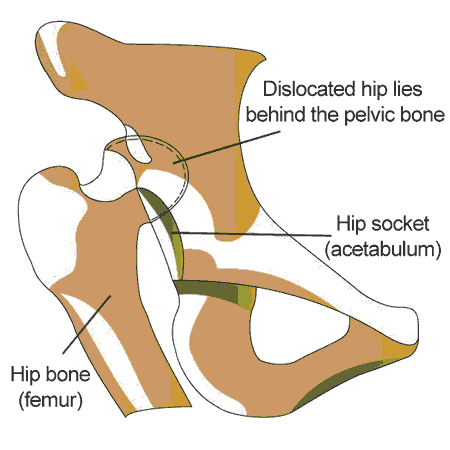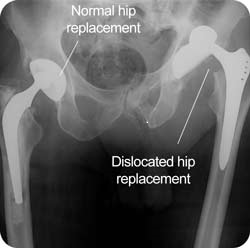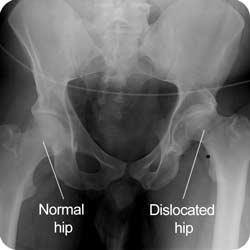A hip dislocation occurs when the top of the femur (thigh bone) slips out of its socket (acetabulum). The acetabulum is a part of the pelvis.

Diagram of a dislocated hip
The hip joint, in a normal adult, is a very stable joint due to its shape and the strong ligaments surrounding it. It usually takes tremendous force to dislocate a hip joint, such as in a severe motor car or motorbike accident.
People who have had a total hip replacement can also dislocate their hip. In this situation, less force may be required and sometimes by just bending over or twisting improperly the hip can dislocate.
Hip dislocations can either occur to the front (anterior) or to the back (posterior). Most hips dislocate to the back.
Some children are born with dislocated hips in a disorder called Developmental Dysplasia of the Hip (DDH).
Symptoms
- Pain: Dislocation of the hip is very painful. This pain is felt in the hip region, upper thigh and groin. Pain may also be felt in the knee, lower leg or lower back due to the dislocation.
- Loss of hip movement: Once dislocated, hip motion will be very difficult. Usually people with a dislocated hip are unable to walk or move their leg at all.
- Numbness: There may be numbness and tingling in the leg due to damage to blood vessels and nerves that run past the hip joint.
- Deformity: The leg of the dislocated hip may appear shorter or longer than the unaffected side depending on which direction the head of the femur has moved during the dislocation. It may also be turned inwards if it is a posterior (to the back) dislocation or turned outward if it is an anterior (to the front) dislocation.
- Swelling and bruising: The hip may swell up quite quickly following the injury, bruising may take several hours to appear.
A pop or tearing sensation may be felt at the time of injury.
Causes
High speed impacts where a large force is transmitted through the hip joint is the most common cause of hip dislocations that do not involve a joint replacement. Examples of this type of injury include:
- Motor vehicle accidents: This is the most common cause of hip dislocation. As many as 70% of hip dislocations have been reported to have been caused by car accidents. The hip is most vulnerable to dislocation when it is bent (flexed) as in the sitting position. During a car accident, the knee may strike the dashboard leading to a force being transmitted through to the hip joint. This usually leads to a posterior (to the back) dislocation.
- High impact sport: Sports such as rugby, AFL, and American football may be a cause of hip dislocation. Most commonly, an athlete is running and jumping, striking the ground while the hip is flexed (bent), adducted (tilted in), and internally rotated (twisted inwards). This is uncommon and is a rare sporting injury.
- Alpine skiing: Posterior dislocations may occur when the knee strikes a solid object after the skier has fallen whilst travelling at high speeds. This is a similar type of injury to that caused by a car accident.
- Falls: A fall from a significant height can lead to dislocation. This may be as a result of an occupational accident.

Total hip replacement: Another cause of dislocation is an unstable hip joint. This is usually due to a past total hip replacement. In this situation, a significant force is not required in order to create a dislocation. Incidental movements, usually with the hip in a bent position, can lead to a dislocation.
Risk Factors
The following risk factors make dislocation more likely:
- Previous hip dislocation
- High impact sports
- Total hip replacement
- Arthritis of the hip – especially rheumatoid and gout
- Poor muscle conditioning
Investigations
Diagnosis of a hip dislocation needs to be made promptly in order to minimize the risk of complications and long term damage. The injured person should not try to use the affected leg. On arrival to a hospital, the doctors will:

- Take a history of the injury, finding out exactly how the injury occurred and whether there are any other relevant conditions that might affect the management of the dislocated hip
- Perform an examination of the affected area by feeling the hip joint and assessing the available movement. They will also check the nerves and blood vessels associated with the hip
- Order an X-ray of the hip which can confirm the diagnosis of hip dislocation
Complications
The hip is normally a very stable joint due to the shape of the joint and the strong ligaments and muscles that surround it. Due to this, a dislocation of the hip may cause damage to these surrounding structures. Complications to the surrounding area include:
- Blood vessel damage: The blood supply to the bones that make up the hip joint, particularly the head of the femur may be affected by a dislocation. This can lead to bone death which is a condition that is known as avascular necrosis (see section). This is a serious condition and may require surgery to maintain the hip joint.
- Nerve damage: Two large nerves – the femoral and sciatic nerve run either side (front and back) of the hip joint. Depending on the direction of the dislocation, these nerves may be damaged. Usually this is only temporary damage leading to pain, numbness or tingling. Permanent injury is uncommon but may occur.
- Fracture: Along with dislocation, there may be a fracture of either the femur (thigh bone) or acetabulum (hip socket).
- Cartilage damage: The hip socket is lined by a ring of cartilage known as the acetabulum. This increases the depth of the socket and contributes to the stability of the hip. This cartilage may be torn during a dislocation.
When the hip joint has been dislocated, there are future complications that may occur months or years following the initial event. These include:
- Recurrent dislocations: Due to damage to the surrounding tissues of the hip, a dislocation makes the hip less stable and increases the risk of further dislocations.
- Osteoarthritis: During a dislocation, the surrounding cartilage may be damaged. This combined with the chance of the hip not tracking as well as it should following a dislocation, increase the risk of developing osteoarthritis.
Treatment
Initial treatment
Hip dislocations are a serious injury and before the hip is treated, a person’s general health needs to be assessed and stabilized. Once this has been carried out by the doctors, they will attempt to put the hip back into place which is known as ‘reduction of the dislocation’.
- Because the hip is surrounded by very strong muscles, it is difficult to put the hip back into place and requires sedation in the form of an anaesthetic as well as medication to relax the muscles and reduce the pain. Once the person with the dislocation is relatively comfortable and sedated, the hip will be manipulated using traction back into place.
- If the dislocation is too difficult to put back into place, or complicated by a fracture, then an operation may be required to effectively return the hip to a normal position.
- Once the hip is back in place, rehabilitation may be required to ensure the muscles around the hip remain strong.
Rehabilitation
A hip dislocation is a major injury. It may take up to 3 months to make a full recovery from this injury. Proper rehabilitation must be performed to return to a normal level of activity. Rehabilitation takes the following path:
- Weight bearing with the help of crutches should begin immediately after the patient is able to stand
- Full weight bearing can begin as the pain further reduces
- Range of motion and strengthening exercises should be carried out under the guidance of a physiotherapist for the six weeks following the injury
- Gradual return to normal activities and sports can occur as pain resolves and movement returns during the following months
Seeking Advice
Hip dislocation is a serious injury and requires urgent medical assessment. The injured person should not attempt to use the hip, nor should they be moved by others.
An ambulance should be called in order to transport the person to the emergency department.
Prevention
Hip dislocations are usually caused by high impact injuries in a normal hip. In order to prevent hip dislocations, avoiding activities that may lead to such an injury is the best method of preventing a hip dislocation.
Hip dislocations also commonly occur in people who have had a hip replacement. In this case, a high impact injury is not necessary in order to dislocate the hip. In the early stages following a hip replacement, to avoid dislocation, you should avoid:
- crossing your legs whilst seated
- bending at the hips past 90 degrees
- turning your affected foot inward or internally rotating your hip
Once rehabilitation of the hip replacement is complete, extreme hip movements should be avoided in order to minimise hip dislocation.
